Asexual and Sexual Reproduction in Plants | Botany - Answer the following questions (Pure Science Group) | 12th Botany : Chapter 1 : Asexual and Sexual Reproduction in Plants
Chapter: 12th Botany : Chapter 1 : Asexual and Sexual Reproduction in Plants
Answer the following questions (Pure Science Group)
Botany : Asexual and Sexual Reproduction in Plants
Answer the following questions (Pure Science Group)
24. What is reproduction?
Answer: (i) It is a process which helps an organism to perpetuate its own species.
(ii) It can be classified into a sexual and sexual reproduction.
25. Mention the contribution of Hofmeister towards Embryology.
Answer: In the year of 1848, Hofmeister described the structure of pollen tetrad.
26. List out two sub-aerial stem modifications with example.
Answer: (i) Runner - Centella asiatica
(ii) Stolon - Fragaria and Mentha.
27. What is layering?
Answer:
(i) It is a conventional method of plant propagation.
(ii) The stem of a parent plant is allowed to develop roots while still intact.
(iii) When the root develops, the rooted part is cut and planted to grow as a new plant.
Example : Ixora and jasminum.
28. What are clones?
Answer: The individuals formed by asexual reproduction are morphologically and genetically identical and are called clones.
29. How do Dioscorea reproduce vegetatively?
Answer: Dioscorea reproduces vegetatively by means of bulbils.
30. A detached leaf of Bryophyllum produces new plants. How?
Answer: Adventitious buds develop in notches in the leaf margins. These are epiphyllous buds, from which the new plants develop.
31. Differentiate Grafting and Layering.
Answer:
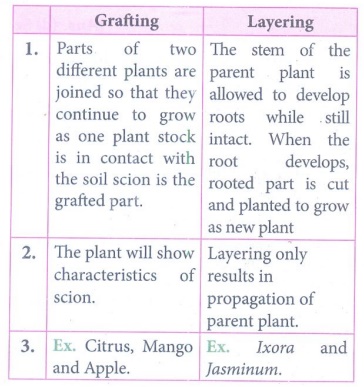
Grafting
1. Parts of two different plants are joined so that they continue to grow as one plant stock is in contact with the soil scion is the grafted part.
2. The plant will show characteristics of scion.
3. Ex. Citrus, Mango and Apple.
Layering
1. The stem of the parent plant is allowed to develop roots while still intact. When the root develops, rooted part is cut and planted to grow as new plant
2. Layering only results in propagation of parent plant.
Ex. Ixora and Jasminum.
32. Write short notes on approach grafting.
Answer: (i) In this
method both the scion and stock remain rooted.
(ii) The stock is grown in a pot and it is brought close to the
scion.
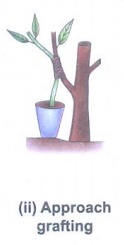
(iii) Both of them should have the same thickness.
(iv) A small slice is cut from both and the cut surfaces are
brought near and tied together and held by a tape.
(v) After 1-4 weeks the tip of the stock and base of the scion
are cut off and detached and grown in a separate pot.
33. “Tissue culture is the best method for propagating rare and endangered plant species”- Discuss.
Answer: The growth of plant tissue in special culture medium under suitable controlled conditions is known as tissue culture.
Micropropagation:
(i) The regeneration of a whole plant from single cell, tissue or small pieces of vegetative structures through tissue culture is called micropropagation.
(ii) This is one of the modern methods used to propagate plants.
Advantages of modern methods:
(i) Plants with desired characteristics can be multiplied rapidly in a short duration.
(ii) Plants produced are genetically identical.
(iii) Tissue culture can be carried out in any season to produce plants.
(iv) Plants which do not produce viable seeds and seeds that are difficult to germinate can be propagated by tissue culture.
(v) Thus this method is ideal to propagate rare and endangered plants.
(vi) Disease free plants can be produced by meristem culture.
34. Distinguish mound layering and air layering.

Answer:
Mound Layering
1. The lower branch with leaves is bent to the ground and part of the stem is buried in the soil and tip of the branch is exposed above the soil.
2. This method is applicable for plants with flexible branches.
3. Hormones are not required to promote rooting
4. A cut is made in parent plant so that the buried part grow into a new plant after root formation.
Air Layering
1. The stem is girdled at nodal region and hormones are applied to this region which promotes rooting.
2. This method is applicable for all types of plants. (flexible and non - flexible branches)
3. Hormones are applied to promote rooting.
4. Branches are removed from the parent plant and grown in a separate pot or ground after root formation.
35. List down the advantages of conventional methods.
Answer: Advantages of
conventional methods
(i) The plants produced are genetically uniform.
(ii) Many plants can be produced quickly by this method.
(iii) Some plants produce little or no seeds; in others, the
seeds produced do not germinate. In such cases, plants can be produced in a
short period by this method.
(iv) Some plants can be
propagated more economically by vegetative propagation.
Example: Solatium tuberosum.
(v) Two different plants with desirable characters such as disease
resistant and high yield can be grafted and grown as new plant with the same
desirable characters.
36. Explain the conventional methods adopted in vegetative propagation of higher plants.
Answer: Conventional methods:
The common methods of conventional propagation are cutting, grafting and layering.
(a) Cutting:
(i) It is the method of producing a newplant by cutting the plant parts such as root, stem and leaf from the parent plant.
(ii) The cut part is placed in a suitable medium for growth.
(iii) It produces root and grows into a new plant. Depending upon the part used it is called as root cutting (Malus), stem cutting (Hibiscus, Bougainvillea and Moringa) and leaf cutting (Begonia, Bryophyllum).
(iv) Stem cutting is widely used for propagation.
(b) Grafting:
(i) In this, parts of two different plants are joined so that they continue to grow as one plant.
(ii) Of the two plants, the plant which is in contact with the soil is called stock and the plant used for grafting is called scion. Examples are Citrus, Mango and Apple. There are different types of grafting based on the method of uniting the scion and stock.
(iii) They are bud grafting, approach grafting, tongue grafting, crown grafting and wedge grafting.
(c) Layering:
(i) In this method, the stem of a parent plant is allowed to develop roots while still intact.
(ii) When the root develops, the rooted part is cut and planted to grow as a new plant. Examples: Ixora and Jasminum.
(iii) Mound layering and Air layering are few types of layering.
37. Highlight the milestones from the history of plant embryology.
Answer: 1682 - Nehemiah Grew mentioned stamens as the male organ of a flower.
1694 - R.J. Camerarius described the structure of a flower, anther, pollen and ovule.
1761 - J.G. Kolreuter gave a detailed account on the importance of insects in pollination.
1824 - G.B. Amici discovered the pollen tube.
1848 - Hofmeister described the structure of pollen tetrad.
1870 - Hanstein described the development of embryo in Capsella and Alisma
1878 - E.Strasburger reported polyembryony.
1884 - E. Strasburger discovered the process of Syngamy.
1898 - S.G. Nawaschin and L. Guignard independently discovered Double fertilization.
1904 - E. Hanning initiated embryo culture.
1950 - D. A. Johansen proposed classification for embryo development.
1964 - S. Guha and S.C. Maheswari raised haploids from Datura pollen grains.
1991 - E.S. Coen and E. M. Meyerowitz proposed the ABC model to describe the genetics of initiation and development of floral parts.
2015 - K.V. Krishnamurthy summarized the molecular aspects of pre and post fertilization reproductive development in flowering plants.
38. Discuss the importance of Modern methods in reproduction of plants.
Answer: Technology is being used for propagation to produce large number of plants in a short period of time. The methods are based on the property of Totipotency shown by plant cells. Modern methods such as tissue culture and micropropagation play a significant role in propagation of plants.
Advantages of modern methods:
(i) Plants with desired characteristics can be multiplied rapidly in a short duration.
(ii) Plants produced are genetically identical.
(iii) Tissue culture can be carried out in any season to produce plants.
(iv) Plants which do not produce viable seeds and seeds that are difficult to germinate can be propagated by tissue culture.
(v) Rare and endangered plants can be propagated.
(vi) Disease free plants can be produced by meristem culture.
(vii) Cells can be genetically modified and transformed using tissue culture.
The methods also have some disadvantages like high cost, skilled labour undesirable genetic changes etc.
39. Differentiate Secretary and invasive tapetum.
Answer:
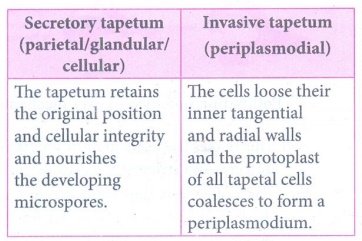
Secretory tapetum (parietal/glandular/cellular)
The tapetum retains
the original position and cellular integrity and nourishes the developing
microspores.
Invasive tapetum (periplasmodial)
The cells loose their
inner tangential and radial walls and the protoplast of all tapetal cells
coalesces to form a periplasmodium.
40. What is Cantharophily.
Answer: The cross pollination of flowers by beetles is called cantharophily. The beetles feed the pollen or on some of the juicy tissues of the flowers.
41. List any two strategy adopted by bisexual flowers to prevent self-pollination.
Answer: Dichogamy: In bisexual flowers anthers and stigmas mature at different times, thus checking self-pollination. It is of two types.
(1) Protandry:
The stamens mature earlier than the stigmas of the flowers.
Examples: Helianthus and Clerodendrum.
(2) Protogyny:
The stigmas mature earlier than the stamens of the flower.
Examples: Scrophularia nodosa and Aristolochia bracteata.
Self sterility/ Self- incompatibility:
In some plants, when the pollen grain of a flower reaches the stigma of the same, it is unable to germinate or prevented to germinate on its own stigma.
Examples: Abutilon, Passiflora. It is a genetic mechanism.
42. What is endothelium.
Answer: (i) It is otherwise known as integumentary tapetum.
(ii) In some species the inner layer of integument may become specialized to perform nutritive function for the embryosac and is called endothelium.
Example: Asteraceae.
43. Name the cell which divides to form male nuclei.
Answer: Generative cells of
Microspore.
44. ‘The endosperm of angiosperm is different from gymnosperm’. Do you agree. Justify your answer.
Answer:
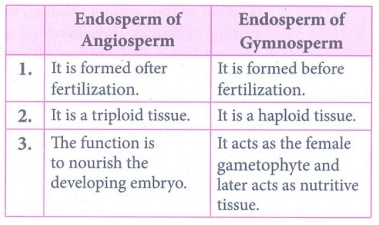
Endosperm of Angiosperm
1. It is formed ofter fertilization.
2. It is a triploid tissue.
3. The function is to nourish the developing embryo.
Endosperm of Gymnosperm
1. It is formed before fertilization.
2. It is a haploid tissue.
3. It acts as the female gametophyte and later acts as nutritive tissue.
Thus the endosperm tissue is different in Angiosperms and gymnosperm.
45. Define the term Diplospory.
Answer: A diploid embryo sac is formed from megaspore mother cell without a regular meiotic division.
Example: Eupatorium and Aerva. It is a type of apomixis.
46. What is polyembryony. How it can commercially exploited.
Answer: Occurrence of more than one embryo in a seed is called polyembryony.
(i) The seedlings formed from the nucellar tissue in Citrus are found better clones for Orchards.
(ii) Embryos derived through polyembryony are found virus free.
47. Do you think parthenocarpy and apomixis are different process. Justify?
Answer: The formation of fruit from the ovary without the act of
fertilization is called parthenocarpy.
A method of
reproduction which does not involve union of male and female gemetes is called
apomixis.
Thus apomixis and
parthenocarpy are asexual modes of reproduction.
(i) But Apomixis refers to formation of seeds without fertilization.
Whereas parthenocarpy refers to formation of fruits without fertilization.
(ii) In Apomixis, the megaspore mother cell does not indergo
mieosis or cell from the nucellus develops into the embryo.
In parthenocarpy, the
ovary becomes a fruit without fertilization and thus fruits are seedless.
Thus Apomixis and
parthenocarpy are different processes.
48. Why does the zygote divides only after the division of Primary endosperm cell.
Answer: (i) Zygote requires nourishment during its development.
(ii) As mature, fertilized embryo sac offers very little nourishment to the zygote, the primary endosperm cell (PEC) divides and generates the endosperm tissue which nourishes the zygote.
(iii) Hence the zygote always divides after division of PEC.
49. What is Mellitophily?
Answer: Pollination of flowers by bees is known as mellitophily.
50. Give examples for Helobial endosperm.
Answer: Hydrilla and Vallisneria.
51. ‘Endothecium is associated with dehiscence of anther’ Justify the statement.
Answer: (i) Endothecium is a single layer of radially elongated cells below the epidermis of anther wall.
(ii) The inner tangential wall develops bands or thickenings of α cellulose.
(iii) In the cells along the junction of two sporangia, the thickenings are absent and this region is called stomium.
(iv) This along with the hygroscopic nature of endothecium helps in the dehiscence of anther at maturity.
52. List out the functions of tapetum.
Answer: (i) It supplies nutrition to the developing microspores.
(ii) It contributes sporopollenin through ubisch bodies thus plays an important role in pollen wall formation.
(iii) The pollenkitt material is contributed by tapetal cells and is later transferred to the pollen surface.
(iv) Exine proteins responsible for ‘rejection reaction’ of the stigma are present in the cavities of the exine. These proteins are derived from tapetal cells.
53. Write short note on Pollen kitt.
Answer: (i) It is a oily layer forming a thick viscous coating at the surface of the pollen.
(ii) The pollenkitt material is contributed by tapetal cells and made of carotenoids or flavonoids. (Orange or Yellow).
(iii) It attracts insects and protects damage from UV radiation.
54. Distinguish tenuinucellate and crassinucellate ovules.
Answer:
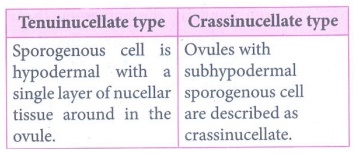
Tenuinucellate type
Sporogenous cell is hypodermal with a single layer of nucellar tissue around in the ovule.
Crassinucellate type
Ovules with subhypodermal sporogenous cell are described as crassinucellate.
Note: These two types of ovules are differentiated based on the position of the sporogenous cell.
55. Give short notes on types of ovules.
Answer: Types of Ovules:
(i) The ovules are classified into six main types based on the
orientation, form and position of the micropyle with respect to funicle and
chalaza.
(ii) Most important ovule types are orthotropous, anatropous,
hemianatropous and campylotropous.
(iii) The types of ovule is given in Figure.
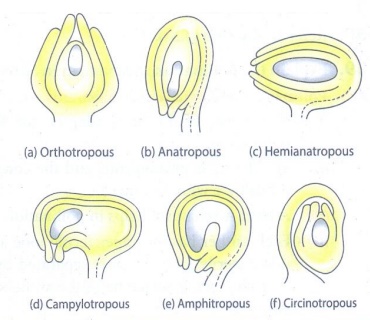
(a) Orthotropous (b)
Anatropous (c) Hemianatropous (d) Campylotropous (e) Amphitropous (f)
Circinotropous
Orthotropous:
The micropyle is at
the distal end and the micropyle the funicle and the chalaza lie in one
straight vertical line.
Examples: Piperaceae, Polygonaceae
Anatropous:
The body of the ovule
becomes completely inverted so that the micropyle and funiculus come to lie
very close to each other. This is the common type of ovules found in dicots and
monocots.
Hemianatropous:
The body of the ovule
is placed transversely and at right angles to the funicle.
Example: Primulaceae.
Campylotropous:
The body of the ovule
at the micropylar end is curved and more or less bean shaped. The embryo sac is
slightly curved. All the three, hilum, micropyle and chalaza are adjacent to
one another, with the micropyle oriented towards the placenta. Example: Leguminosae.
In addition to the
above main types there are two more types of ovules they are,
Amphitropous: The distance between hilum and chalaza is less. The
curvature of the ovule leads to horse-shoe shaped nucellus.
Example: some Alismataceae.
Circinotropous: Funiculus is very long and surrounds the ovule. Example: Cactaceae.
56. ‘Pollination in Gymnosperms is different from Angiosperms’ – Give reasons.
Answer:
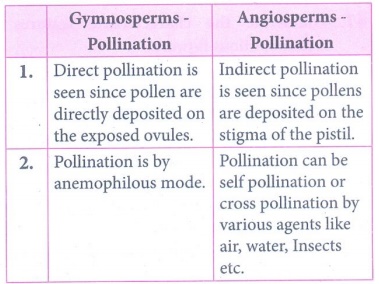
Gymnosperms – Pollination
1. Direct pollination is seen since pollen are directly deposited on the exposed ovules.
2. Pollination is by anemophilous mode.
Angiosperms – Pollination
1. Indirect pollination is seen since pollens are deposited on the stigma of the pistil.
2. Pollination can be self pollination or cross pollination by various agents like air, water, insects etc.
57. Write short note on Heterostyly.
Answer: It is a contrivance of cross pollenation. Some plants produce two or three different forms of flowers that are different in their length of stamens and style. Pollination will take place only between organs of the same length. (Figure)
(a) Distyly:
(i) The plant produces two forms of flowers, Pin or long style, long stigmatic papillae, short stamens and small pollen grains; Thrum-eyed or short style, small stigmatic papillae, long stamens and large pollen grains.
Example: Primula (Figure).
(ii) The stigma of the Thrum-eyed flowers and the anther of the pin lie in same level to bring out pollination.
(iii) Similarly the anther of Thrum-eyed and stigma of pin ones is found in same height. This helps in effective pollination.
(b) Tristyly:
(i) The plant produces three kinds of flowers, with respect to the length of the style and stamens.
(ii) Here, the pollen from flowers of one type can pollinate only the other two types but not their own type.
Example : Lythrum.
58. Enumerate the characteristic features of Entomophilous flowers
Answer: (i) Flowers are generally large or if small, they are aggregated in dense inflorescence.
Examples: Asteraceae flowers.
(ii) Flowers are brightly coloured. The adjacent parts of the flowers may also be brightly coloured to attract insects.
Examples: Poinsettia and Bougainvillea the bracts become coloured.
(iii) Flowers are scented and produce nectar.
(iv) Flowers in which there is no secretion of nectar, the pollen is either consumed as food or used in building up of its hive by honey bees. Pollen and Nectar are the floral rewards for the visitors.
(v) Flowers pollinated by flies and beetles produce foul odour to attract insects.
(vi) In some flowers juicy cells are present which are pierced and the contents are sucked by the insects.
59. Explain the pollination mechanism in Salvia.
Answer: Pollination in Salvia (Lever mechanism):
(i) The flower of Salvia
is adapted for Bee pollination.
(ii) The flower is protandrous and the corolla is bilabiate with
2 stamens.
(iii) A lever mechanism helps in pollination.
(iv) Each anther has an upper fertile lobe and lower sterile
lobe which is separated by a long connective which helps the anthers to swing
freely.
(v) When a bee visits a flower, it sits on the lower lip which
acts as a platform.
(vi) It enters the
flower to suck the nectar by pushing its head into the corolla.
(vii) During the entry of the bee into the flower the body
strikes against the sterile end of the connective.
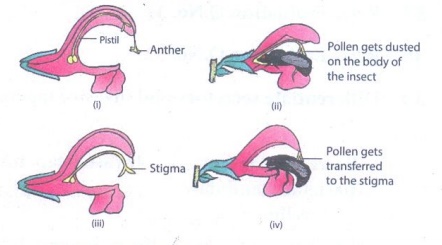
Pollination in Salvia
- Lever mechanism
(viii) This makes the fertile part of the stamen to descend and
strike at the back of the bee.
(ix) The pollen gets deposited on the back of the bee. When it
visits another flower, the pollen gets rubbed against the stigma and completes
the act of pollination in Salvia.
60. Discuss the steps involved in Microsporogenesis.
Answer: The stages involved in the formation of haploid microspores from diploid microspore mother cell through meiosis is called Microsporogenesis.
(i) The primary sporogeneous cells directly, or may undergo a few mitotic divisions to form sporogenous tissue.
(ii) The last generation of sporogenous tissue functions as microspore mother cells.
(iii) Each microspore mother cell divides meiotically to form a tetrad of four haploid microspores (microspore tetrad).
(iv) The microspore tetrad may be arranged in a tetrahedral, decussate, linear, T shaped or isobilateral manner.
(v) Microspores soon separate from one another and remain free in the anther locule and develop into pollen grains.
(vi) In some plants, all the microspores in a microsporangium remain held together called pollinium.
Example: Calotropis. Compound pollen grains are found in Drosera and Drymis.
61. With a suitable diagram explain the structure of an ovule.
Answer: (i) Ovule is also called megasporangium and is protected by one or two covering called integuments.
(ii) A mature ovule consists of a stalk and a body. The stalk or the funiculus is present at the base and it attaches the ovule to the placenta.
(iii) The point of attachment of funicle to the body of the ovule is known as hilum.
(iv) In an inverted ovule, the funicle is adnate to the body of the ovule forming a ridge called raphe.
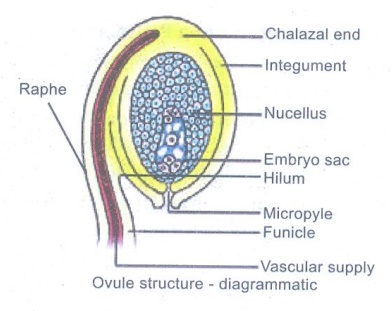
(v) The body of the ovule is made up of a central mass of parenchymatous tissue called nucellus which has large reserve food materials.
(vi) The nucellus is enveloped by one or two protective coverings called integuments.
(vii) Integument encloses the nucellus completely except at the top where it is free and forms a pore called micropyle.
(viii) The ovule with one or two integuments are said to be unitegmic or bitegmic ovules respectively.
(ix) The basal region of the body of the ovule where the nucellus, the integument and the funicle meet or merge is called as chalaza.
(x) There is a large, oval, sac-like structure in the nucellus toward the micropylar end called embryo sac or female gametophyte.
(xi) It develops from the functional megaspore formed within the nucellus.
(xii) In some species (unitegmic tenuinucellate) the inner layer of the integument may become specialized to perform the nutritive function for the embryo sac and is called as endothelium or integumentary tapetum
Example: Asteraceae.
(xiii) There are two types of ovule based on the position of the sporogenous cell.
(a) If the sporogenous cell is hypodermal with a single layer of nucellar tissue around it is called tenuinucellate type. Normally tenuinucellate ovules have very small nucellus.
(b) Ovules with subhypodermal sporogenous cell is called crassinucellate type. These ovules have fairly large nucellus.
(xiv) Group of cells found at the base of the ovule between the chalaza and embryo sac is called hypostase and the thick -walled cells found above the micropylar end above the embryo sac is called epistase.
62. Give a concise account on steps involved in fertilization of an angiosperm plant.
Answer: The fusion of male and female gamete is called fertilization.
Events of fertilization:
(i) Germination of pollen to form pollen tube in the stigma.
(ii) Growth of pollen tube in the style.
(iii) Direction of pollen tube towards micropyle of ovule.
(iv) Entry of the pollen tube into embryo sac.
(v) Discharge of male gametes.
(vi) Syngamy.
(vii) Triple fusion.
Germination of pollen on stigma:
(i) The events from pollen deposition on the stigma to entry of pollen tube into the ovule is called pollen pistil interaction. This involves recognition of pollen and promotion / inhibition of germination and growth.
(ii) If the pollen is compatible with the stigma it germinates to form a tube. This is facilitated by fluid in wet stigma and pellicle in dry stigma. The compatibility depends on recognition-rejection protein reaction between the pollen and stigma surface. All cytoplasmic contents move to the tip of pollen tube which is hemispherical and transparent. This is called cap block.
Growth of pollen tube in the style:
(i) The growth of the pollen tube through the style depends an the type of style.
(ii) Styles may be hollow; solid or semi-solid.
(iii) The style is lined internally by a single layer of glandular cells called Transmitting tissue.
(iv) This provides nourishment for the pollen tube and also controls the incompatibility between style and pollen tube.
Entry of pollen tube into the ovule:
The pollen tube enters the ovule through the micropyle (Porogamy) or chalaza (Chalazogamy) or integument (Mesogamy).
Entry of pollen tube into embryo sac:
(i) Pollen tube enters the embryo sac at the micropylar end only.
(ii) A structure known as the obturator guides the pollen tube towards micropyle of the ovule.
(iii) After entering into the embryo sac, a pore is formed in the pollen tube wall behind the apex.
(iv) The content of the pollen tube (two male gametes, vegetative nucleus and cytoplasm) are discharged into the synergids into which pollen tube enters. The tube nucleus disorganizes.
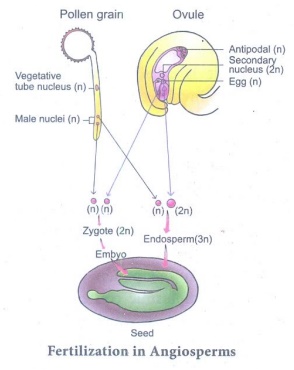
Double fertilization and triple fusion:
(i) Both the male gametes are involved in fertilization.
(ii) The phenomenon is called double fertilization.
(iii) One male gametes fuses with the egg nucleus (syngamy) to form Zygote.
(iv) The second male gamete fuses with the polar nuclei (secondary nucleus) to form primary endosperm nucleus.
(v) Since this involves fusion of three nuclei, the phenomenon is known as triple fusion. This results in formation of endosperm which is the nutritive tissue for the growing embryo.
63. What is endosperm. Explain the types.
Answer: The primary endosperm nucleus (PEN) divides immediately after fertilization into an endosperm. The primary endosperm nucleus is the result of triple fusion (two polar nuclei and one sperm nucleus) and thus has 3n number of chromosomes. It is a nutritive tissue and regulatory structure that nourishes the developing embryo.
I. Depending upon the mode of development, 3 types of endosperm are recognized in angiosperms. They are:
Nuclear endosperm:
(i) Primary endosperm nucleus (PEN) divides into two without any wall formation.
(ii) The subsequent division of these two nuclei are free nuclear so that the endosperm consists of only free nuclei and cytoplasm around them.
(iii) The nuclei may either remain free or may become separate by walls in later stages.
Example: Coccinia, Capsella and Arachis.
Cellular endosperm:
(i) The primary endosperm nucleus (PEN) divides into 2 nuclei which are immediately followed by a wall formation.
(ii) Subsequent divisions are also followed by walls.
Example: Adoxa, Helianthus and Scoparia.
Helobial endosperm:
(i) The primary endosperm nucleus (PEN) moves towards the base of the embryo sac and divides into two nuclei.
(ii) These 2 nuclei are separated by a wall to form a large micropylar chamber and a small chalazal chamber.
(iii) The nucleus of the micropylar chamber undergoes several free nuclear divisions whereas that of the chalazal chamber may or may not divide.
Example: Hydrilla and Vallisneria.
II. Endospermous and Non-endospermous seeds:
The endosperms may either be completely consumed by the developing embryo or it may persist in the mature seeds.
(i) Those seeds without endosperms are called non- endospermous or ex- albuminous seeds. Examples: Pea, Groundnut and Beans.
(ii) Those seeds with endosperms are called endospermous or albuminous seeds. The endosperms in these seeds supply nutrition to the embryo during seed germination. Example: Paddy, Coconut and Castor.
III. Ruminate endosperm:
The endosperm with irregularity and unevenness in its surface forms ruminate endosperm.
Example: Areca catechu.
64. Explain the development of a Dicot embryo
Answer: Development of Dicot embryo:
Development of Dicot
embryo (Capsella bursapastoris) is of Onagrad or crucifer type. The embryo
develops at micropylar end of embryo sac.
(i) The Zygote divides by a transverse division forming upper or terminal cell and lower or basal cell. The basal cell
divides transversely and the terminal cell divides vertically to form a 4
celled proembryo.
(ii) A second vertical division right angle to the first one
takes place in terminal cell forming a 4 celled stage called quadrant.
(iii) Transverse division in the quadrant results in 8 cells
arranged in 2 tiers of 4 each called
octant stage.
(iv) Upper tier of 4 cells of the octant is called epibasal or
anterior octant and the lower tier of four cells constitute hypobasal or posterior octants.
(v) A periclinal division in the octants results in the
formation of 16 celled stage with 8
cells in the outer and eight in the inner.
(vi) The outer 8 cells represent the dermatogen and undergoes
anticlinal division to produce epidermis.
(vii) The inner 8 cells divide by vertical and transverse
division to form outer layer of periblem
which give rise to cortex and a central region of pleurome which forms stele. During the development, the 2 cells of
the basal cell undergoes several transverse division to form a 6 to 10 celled suspensor.
(viii) The embryo at this stage become globular and the suspensor
helps to push the embryo deep into the endosperm.
(ix) The uppermost cell of the suspensor enlarge to form a
haustorium. The lowermost cell of the suspensor is called hypophysis.
(x) A transverse division and two vertical division right angle
to each other of hypophysis results in the formation of 8 cells.
(xi) The eight cells are arranged in two tiers of 4 cells each. The upper tier give rise
to root cap and epidermis.
(xii) At this stage embryo proper appears heart shaped, cell
divisions in the hypocotyl and cotyledon regions of the embryo proper
results in elongation.
(xiii) Further development results in curved horse shoe shaped
embryo in the embryo sac. The mature embryo has a radicle, hypocotyl, two cotyledons
and a plumule.
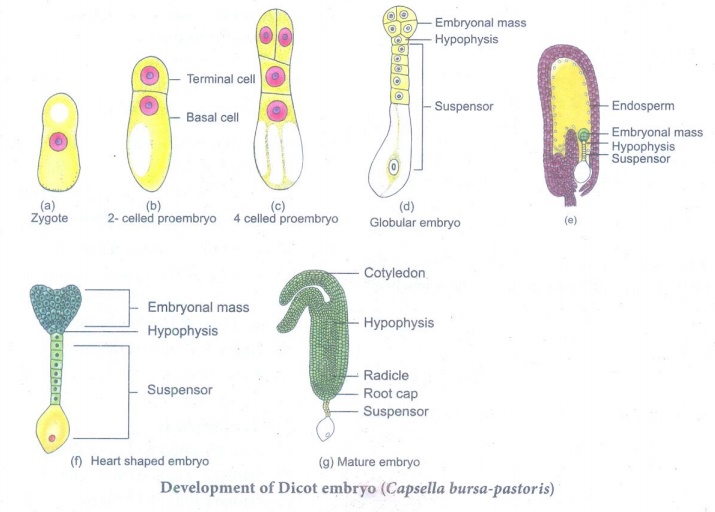
Development of Dicot
embryo (Capsella bursa-pastoris)
65. Differentiate the structure of Dicot and Monocot seed.
Answer:
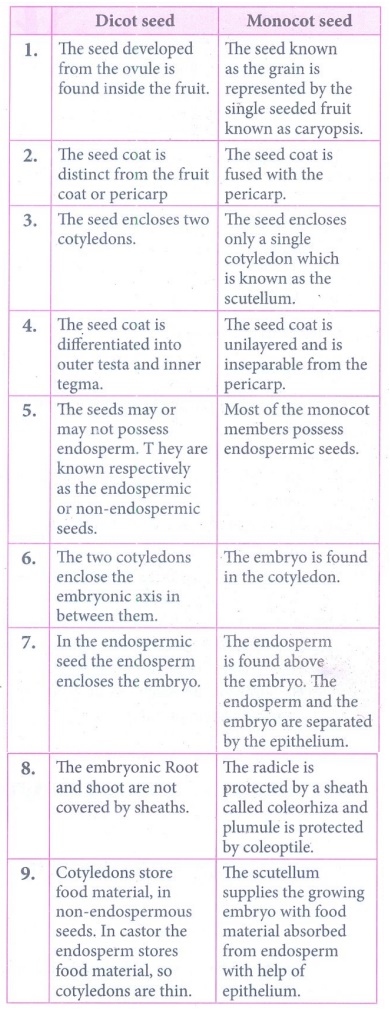
Dicot seed
1. The seed developed from the ovule is found inside the fruit.
2. The seed coat is distinct from the fruit coat or pericarp
3. The seed encloses two cotyledons.
4. The seed coat is differentiated into outer testa and inner tegma.
5. The seeds may or may not possess endosperm. They are known respectively as the endospermic or non-endospermic seeds.
6. The two cotyledons enclose the embryonic axis in between them.
7. In the endospermic seed the endosperm encloses the embryo.
8. The embryonic Root and shoot are not covered by sheaths.
9. Cotyledons store food material, in non-endospermous seeds. In castor the endosperm stores food material, so cotyledons are thin.
Monocot seed
1. The seed known as the grain is represented by the single seeded fruit known as caryopsis.
2. The seed coat is fused with the pericarp.
3. The seed encloses only a single cotyledon which is known as the scutellum.
4. The seed coat is unilayered and is inseparable from the pericarp.
5. Most of the monocot members possess endospermic seeds.
6. The embryo is found in the cotyledon.
7. The endosperm is found above the embryo. The endosperm and the embryo are separated by the epithelium.
8. The radicle is protected by a sheath called coleorhiza and plumule is protected by coleoptile.
9. The scutellum supplies the growing embryo with food material absorbed from endosperm with help of epithelium.
66. Give a detailed account on parthenocarpy. Add a note on its significance.
Answer: Parthenocarpy:
(i) Fruit like structures may develop from the ovary without the act of fertilization. Such fruits are called parthenocarpic fruits.
(ii) Many commercial fruits are made seedless.
Example: Banana, Grapes and Papaya.
(iii) Nitsch in 1963 classified parthenocarpy into following types:
(a) Genetic parthenocarpy:
Parthenocarpy arises due to hybridization or mutation.
Example: Citrus and Cucurbita.
(b) Environmental parthenocarpy: Environmental conditions like frost, fog, low temperature, high temperature etc., induce parthenocarpy. For example, low temperature for 3-19 hours induces parthenocarpy in Pear.
(c) Chemically induced parthenocarpy: Application of growth promoting substances like Auxins and Gibberellins induces parthenocarpy.
Significance:
(i) The seedless fruits have great significance in horticulture.
(ii) The seedless fruits have great commercial importance.
(iii) Seedless fruits are useful for the preparation of jams, jellies, sauces, fruit drinks etc.
(iv) High proportion of edible part is available in parthenocarpic fruits due to the absence of seeds.
Related Topics